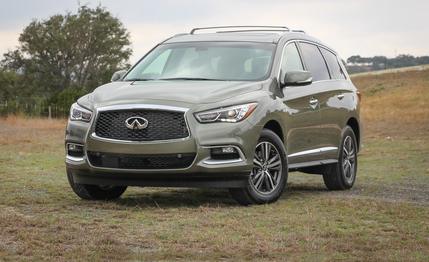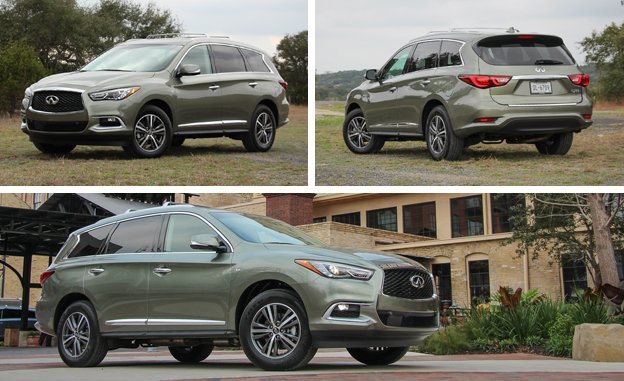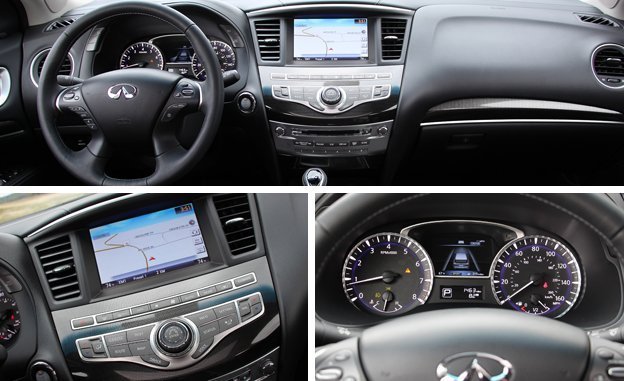
 First Drive Review
First Drive Review
Ostensibly a luxury brand peddling vehicles with a performance bent, Infiniti has found itself in a tricky place as the market embraces crossovers. Its first such effort, the two-row FX (now dubbed QX70), was brazen, brawny, and butch, and very much in sync with the brand’s stated values. But when time came for Infiniti to offer something with three rows—beyond the truckish, body-on-frame QX80, that is—it erred on the side of cushiness with the soft, creamy, and benign QX60 (which launched as the JX for 2013). Basically, Infiniti had built itself a Lexus.
Now, for its 2016 refresh, Infiniti ventured beyond the normal nip and tuck, adding some chassis tweaks to make its second-bestselling model more of an Infiniti.


Design-wise, the Infinitization effort brings sterner headlamps, LED fog lamps, and a new fascia with a gaping lower air intake below a mesh grille complete with an enlarged Infiniti badge. There also are revised tailgate and rear-bumper designs, new quad-element taillamps, and new 18- and 20-inch wheels. The interior changes are more subtle, although a welcome infusion of padded and stitched dash and door materials bring it at least up to par for the segment, if not to the top. The 2016 QX60 also gets a trio of new USB ports and a new shifter design, the latter soon to make its way across the Infiniti lineup.
Both of the QX60 powertrains carry over, including the 268-hp 3.5-liter V-6 and continuously variable transmission (CVT) combo that proved capable of urging a four-wheel-drive version to 60 mph in 7.8 seconds. Unfortunately, the engine still sounds coarse under full throttle and the noise is hard to ignore, as the CVT elevates engine rpm in such situations. The smoother and quieter, 250-hp four-cylinder hybrid powertrain is still available, but with cheap gas, it has become so unpopular that it’s available only to those who bother with placing a special order.
In response to what Infiniti attributes to media and customer feedback, and to sync up with the brand’s performance orientation, the chassis changes are aimed at giving the QX60 a more connected feel. These include a quicker steering gear for crisper response, new dampers, and revised spring rates. On the road, we observed that the steering indeed responds quite directly, and some road texture is transmitted through the wheel—certainly a welcome change from before. But thanks to the Infiniti’s stiffer suspension, the driver isn’t the only one who feels the road more: Pavement imperfections large and small can be felt sharply by passengers in all rows. The firmer ride quality would be considered an improvement if it helped make the QX60 feel truly athletic, but it doesn’t; it still rolls noticeably in corners, and it can’t mask its hefty curb weight. For what it’s worth, the QX60 does feel less like a Lexus and more like an Infiniti, so in that regard, the update is a success. But we don’t expect too many BMW X5 intenders to defect to Infiniti based on the QX60’s dynamics.


One can make a case for the QX60 next to the X5 or the Audi Q7 when price is factored in. The QX60’s starting figure of $43,595 ($45,395 for the four-wheel-drive model) is many thousands of dollars less, with popularly equipped models landing between $50K and $55K. However, next to other competitors like the excellent new Volvo XC90, which starts at $44,945, and the $43,955 Acura MDX, the QX60 loses ground.
At the very least, the 2016 QX60 does a good job filling its own shoes, and thus it should help Infiniti continue to capitalize on the constant influx of new luxury-crossover buyers, until a completely redesigned version arrives in two or three years. By then, we hope Infiniti finds a way to build a three-row crossover that feels as lithe and engaging as its brand promises.